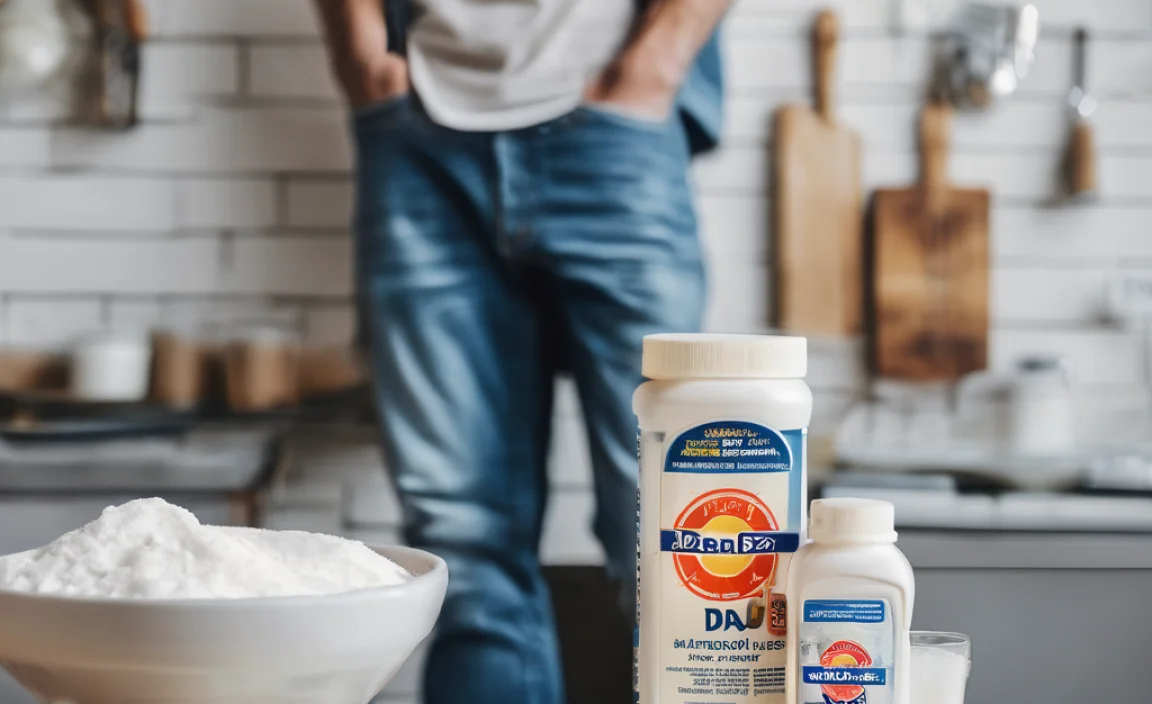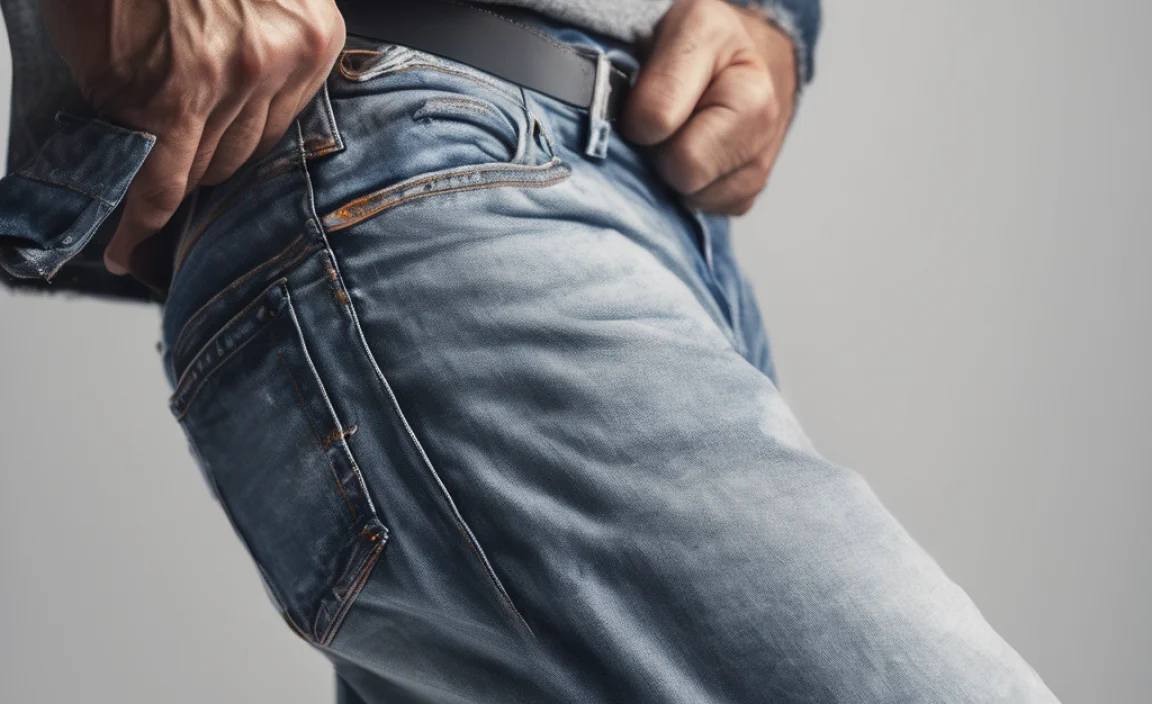Hemming your dad jeans at home is simple with our easy baking soda method! This guide shows you how to get that perfect fit without a sewing machine, ensuring a clean, professional look in no time. Save time and money with this no-sew solution.
Dad jeans. We love them for their comfort and laid-back style, but sometimes, they’re just a little too long. You could take them to a tailor, but that can be pricey. You could try sewing them yourself, but not everyone has a sewing machine or the skills. What if there was a super simple, no-sew way to get that perfect hem? Good news – there is! This guide will walk you through a genius method using common household items to get your dad jeans looking sharp. Get ready to adjust your favorite denim to perfection, easily and affordably.
Why Hemming Matters for Dad Jeans

The “dad jean” silhouette is iconic. It’s known for its relaxed fit, often a straight leg, and a slightly higher rise. While this style is effortlessly cool, its generous length can sometimes be a downfall. Jeans that are too long can drag on the floor, get dirty quickly, and even look sloppy. A proper hem doesn’t just shorten the jeans; it refines the overall look of the garment. It ensures your jeans sit perfectly on your shoes, whether you’re rocking sneakers or boots, and contributes to a polished appearance, even with a casual style choice like dad jeans.
For beginners, the idea of altering clothing can be intimidating. However, understanding how to fix a simple fit issue like length is empowering. It’s a practical skill that saves money and extends the life of your wardrobe. Dad jeans, with their often thicker denim and simpler construction, are excellent for practicing basic alterations. You don’t need fancy equipment; just a desire for a better fit.
The “Genius” Baking Soda Method: An Overview

So, what’s this baking soda magic? It’s a clever, no-sew technique that uses baking soda and heat to create a temporary, yet surprisingly effective, fold that mimics a hem. The baking soda acts as a mild abrasive and helps to set the fold when ironed. Think of it as a gentle way to “teach” your denim where you want the new hemline to be, without any stitches. This method is ideal for those times when you want a quick fix or are not ready to commit to permanent alterations. It’s also fantastic for denim that might be slightly stretchy or delicate, as it avoids the direct pressure of tight stitching.
This method stands out because it’s accessible to absolutely anyone. No sewing machine? No problem. No iron? Well, you’ll need one for setting the fold, and even a basic one will do. It’s about repurposing everyday items to solve a common fashion problem. You’re essentially creating a temporary press-in hem that looks remarkably neat.
What You’ll Need

Gathering your supplies is the first step to success. This method relies on items you likely already have around your house, making it incredibly convenient.
- Your Dad Jeans: Make sure they are clean and dry.
- Baking Soda: About 2-3 tablespoons.
- Water: A small amount to make a paste.
- An Old Toothbrush or Small Brush: For applying the paste.
- An Iron: A standard household iron is perfect.
- A Sturdy Ironing Board: For a stable surface.
- Measuring Tape or Ruler: To ensure even hemming.
- Fabric Scissors (Optional but Recommended): For trimming excess fabric if you decide to make it permanent later.
- Fabric Chalk or a Washable Marker (Optional): To mark your desired hemline.
- A Spray Bottle with Water: For dampening the fabric as needed.
Step-by-Step: The Baking Soda Hemming Process

Let’s get started! Follow these steps carefully, and you’ll have perfectly hemmed dad jeans in no time. Remember, clear instructions are key to a great result.
Step 1: Determine Your Desired Length
Put on your dad jeans and the shoes you typically wear with them. Stand in front of a mirror and decide where you want the hem to fall. You can have them hit just at the top of your shoe, slightly above your ankle, or even a bit higher for a cropped look. Use a fabric chalk or washable marker to make a small dot on the outside seam of each leg to mark your desired hemline. This is crucial for a consistent finish. If you don’t have chalk, you can use a pin carefully.
Tip: It’s always better to start with a slightly longer hem than you think you want. You can always trim more off later, but you can’t add fabric back!
Step 2: Create the Baking Soda Paste
In a small bowl, mix about 2-3 tablespoons of baking soda with just enough water to create a thick paste. You want it to be spreadable but not watery. Think of the consistency of toothpaste. This paste will help the fabric remember its folded shape.
Step 3: Mark and Fold the Jeans
Lay one leg of your dad jeans flat on your ironing board. You’ll be working with a doubled-up section of the leg because you’re creating an internal fold. Measure from the bottom of the jean leg up to your marked hemline, and then double that measurement. This is how much fabric you need to fold up. For example, if you want to shorten your jeans by 2 inches, you’ll need to fold up 4 inches of fabric. Use your measuring tape and fabric chalk to mark a straight line 4 inches above the current hem on the inside of the leg. Carefully fold the bottom of the jean leg upwards along this line, so the original raw edge of the denim is now tucked inside the fold, hidden from view. The new bottom edge of your jean will be at your desired length.
Note: It’s important that the fold is crisp and even all the way around the leg. Use your hands to smooth it out.
Step 4: Apply the Baking Soda Paste
Using your old toothbrush or small brush, apply the baking soda paste along the folded edge of the fabric. Make sure to coat the inside fold where the original hem was. You want to get a good layer of the paste onto the fabric. It doesn’t need to be soaked, just applied thoroughly along the folded crease.
Step 5: Dampen and Iron
Lightly dampen the area with the baking soda paste using your spray bottle of water. It should be moist but not dripping wet. Now, use your iron on a medium-high heat setting (check your denim care label) and carefully iron over the damp baking soda paste. Press down firmly for about 15-20 seconds. This heat and moisture, combined with the baking soda, help to press the fold into the fabric. Work your way around the entire jean leg, re-dampening and ironing as needed.
Important: Always iron on a protected surface. Ensure your ironing board cover is in good condition. Test your iron’s heat on an inconspicuous area of the jeans if you’re unsure.
Step 6: Let It Set
Once you’ve ironed the entire folded hem, resist the temptation to unfold it immediately. Allow the fabric to cool and dry completely. This setting period is crucial for the bake soda method to work properly and for the fold to hold its shape. You can let it air dry, or if you’re in a hurry, you can use a fan. Let it sit for at least 30 minutes, or until totally dry.
Step 7: Check and Repeat if Necessary
Gently let the folded fabric unfold slightly to check the hold. If the hem is holding well and you’re happy with the length, congratulations! You’ve successfully hemmed your dad jeans. If the fold isn’t as crisp or secure as you’d like, you can re-apply a little paste, dampen, and iron again. You might need to do a second pass to really set the fold.
Step 8: Final Touches (Optional)
For a more permanent solution or if the baking soda method isn’t quite holding up to wear, you can now consider making your no-sew hem permanent. You can use fabric glue or hemming tape to secure the fold. If you want a true sewn hem, this is when you would trim off the excess fabric and sew it properly. For now, the baking soda method provides a neat, temporary hem that works well for many occasions.
Pros and Cons of the Baking Soda Method

Like any DIY technique, the baking soda method has its advantages and disadvantages. Understanding these will help you decide if it’s the right choice for your needs.
| Pros | Cons |
|---|---|
| Very Beginner-Friendly: Requires no sewing skills. | Can Be Temporary: The hem may loosen over time or with frequent washing. |
| Cost-Effective: Uses common household items. | May Not Be Permanent: Not as durable as a sewn hem. |
| No Special Tools Needed: Just an iron and basic items. | Potential for Residue: Baking soda might leave a slight white residue if too much is used or not fully washed out. |
| Gentle on Fabric: Avoids tight stitches that can damage delicate denim. |
Requires Re-application: May need to be redone after several washes. |
| Quick and Easy: A fast way to adjust jean length. | No Traditional “Stitch” Finish: Doesn’t have the authentic look of a sewn hem. |
When This Method Shines (and When to Consider Other Options)
The baking soda method is perfect for quick fixes, temporary adjustments, or if you’re still experimenting with your preferred jean length. It’s also a great option for keeping a pair of “going out” jeans from dragging on the floor without committing to a permanent change. For special occasions where you need your jeans to look just right for a day or two, this method is a lifesaver.
However, if you’re looking for a permanent alteration, or if your dad jeans are worn very frequently and subjected to rigorous washing, a traditional sewn hem (either by hand or machine) or a professional tailoring job would be more durable. For very thick or heavily-lined denim, a sewn hem might also provide a cleaner, more stable result. If you’re interested in permanent no-sew options, techniques like using fabric glue or iron-on hemming tape are excellent alternatives, offering more durability than the baking soda method but still avoiding sewing machines. You can find detailed guides on these at resources like The U.S. Department of Agriculture (USDA) (while not directly about sewing, their guides on material care often touch on fabric properties) or through reputable craft and textile sites focused on DIY fashion.
Maintaining Your Hemmed Jeans
To help your baking soda hem last as long as possible, treat your jeans with care. When it’s time to wash them, turn your dad jeans inside out. This helps protect the folded hem from excessive stress during the wash cycle. Use a gentle washing cycle with cold water. Avoid using harsh detergents. If possible, consider hand-washing them or using a delicate laundry bag.
For drying, air-drying is always the best option for preserving the shape and integrity of the hem. Lay the jeans flat or hang them to dry, making sure the hem remains crisp. If you must use a dryer, opt for a low heat setting and remove them while they are still slightly damp to prevent shrinkage or damage to the fold. You may need to re-iron the hem periodically to maintain its crispness, especially if you notice it starting to relax.
Frequently Asked Questions (FAQ)
Q1: Can I use this method on any type of jeans?
This method works best on standard denim, especially looser fits like dad jeans. It might be less effective on very stretchy or thin denim, as the fold may not hold as firmly. It’s also not recommended for very thick, lined, or rigid denim where achieving a crisp fold is difficult.
Q2: Will the baking soda leave a stain or residue?
If you use too much baking soda or don’t rinse it out properly after ironing, it can leave a slight white residue. To minimize this, use only enough paste to lightly coat the fold, dampening it sufficiently but not soaking it. Washing the jeans inside out after the initial hemming should help remove any residual powder.
Q3: How long will this hem last?
The longevity of the hem depends on how often you wear and wash the jeans. It’s a temporary solution. For daily wear and frequent washing, you might need to re-iron the hem every few weeks or months. For occasional wear, it can last significantly longer.
Q4: Do I have to use an iron?
Yes, the iron is essential to set the fold with the baking soda and moisture. The heat activates the baking soda’s properties and presses the fabric crease. Without an iron, the fold will not set properly.
Q5: Can I make this hem permanent without sewing?
While the baking soda method is temporary, you can make no-sew hems more permanent using fabric glue specifically designed for denim or iron-on hemming tape. These alternatives offer stronger adhesion than the baking soda method alone and are a good option if you want a lasting result without sewing.
Q6: What if my jeans are really long and I need to shorten them a lot?
If you need to shorten your jeans by more than 3-4 inches, this baking soda method might be challenging to maintain a crisp fold. For significant alterations, it’s usually best to consider a traditional sewn hem or seek professional tailoring for the cleanest and most durable results.
Conclusion: Confidence in Every Step
Mastering simple clothing alterations like hemming your dad jeans can be incredibly empowering. The baking soda method offers a practical, accessible, and budget-friendly way to achieve a great fit without needing specialized sewing skills. It’s a testament to how clever use of everyday items can solve common problems. By following these straightforward steps, you can transform ill-fitting jeans into perfectly tailored favorites, enhancing your style and your confidence. Remember, the goal is a better fit that makes you feel great, and this genius method is a fantastic starting point for any beginner looking to take control of their wardrobe. So go ahead, adjust those jeans, and step out with a perfect hem!











